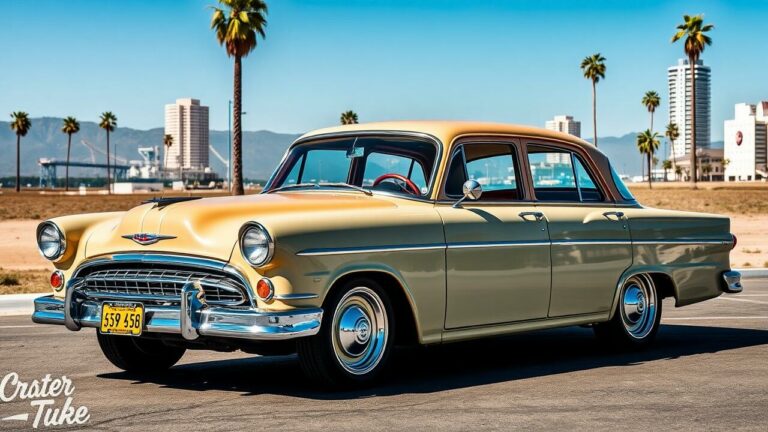The Difference Between Midsize and Full size Sedans
Table Of Contents
The Difference Between Midsize And Full Size Sedans | Understanding the Difference Between Midsize and Full-Size Sedans: A Guide to Mid-Size Sedans
Key Takeaways
- Distinction between mid-size and large sedans along with a summary of vehicle classifications.
- Essential features of mid-size sedans.
- Fundamental traits of large sedans.
- Evaluation of mid-size versus large sedans.
- Selecting the perfect sedan dimension.
- Mid-size vehicles compared to mid-size SUVs.
The Difference Between Midsize And Full Size Sedans | Overview of Sedan Categories
Understanding The Difference Between Midsize and Full Size Sedans is crucial for potential buyers seeking the right vehicle for their needs. Midsize sedans, such as the Honda Accord or Toyota Camry, typically offer a spacious interior and efficient fuel economy, making them ideal for daily commutes or family outings. They strike a balance between size and maneuverability, appealing to those who may find a full-size sedan too cumbersome. On the other hand, full-size sedans, like the Chevrolet Impala or Ford Taurus, provide more room and luxury features, often catering to those who prioritize comfort and performance. Potential buyers must carefully consider their lifestyle preferences and driving needs to choose between a midsize car, a full-size sedan, or even a midsize SUV.
The Difference Between Midsize and Full size Sedans | Defining Midsize Sedans
Midsize sedans strike a balance between compact sedans and full-size vehicles, catering to drivers seeking a larger car without going for the full-size option. These mid-size cars typically feature spacious interiors that comfortably accommodate passengers while remaining maneuverable in urban settings. The Difference Between Midsize and Full size Sedans often comes down to dimensions, as midsize sedans offer a generous amount of trunk space as well, making them a practical choice for various lifestyles.
Midsize sedans usually measure between full-size cars and smaller cars, with engine options that deliver satisfactory performance without the heft of a full-size vehicle. They provide a comfortable riding experience that appeals to those who require a blend of fuel efficiency and interior space. The Difference Between Midsize and Full size Sedans showcases how midsize models can efficiently meet the needs of drivers who appreciate the advantages of larger cars without the bulk that comes with full-size vehicles.
Defining FullSize Sedans
Full-size sedans are designed to provide ample space and comfort, making them ideal for families and individuals seeking a spacious ride. These cars typically feature larger interiors compared to their midsize counterparts, allowing for more legroom and headroom. Unlike compact cars or smaller cars, full-size sedans can accommodate more passengers and cargo, which is a significant advantage for long trips. The difference between midsize and full-size sedans is particularly evident in their dimensions, with the latter often offering a more luxurious atmosphere that might even rival some luxury cars.
In terms of performance, full-size sedans often boast powerful engines that deliver a smooth and responsive driving experience. They are built to handle various road conditions while maintaining comfort and stability. Unlike SUVs, which provide higher ground clearance and ruggedness, full-size sedans prioritize a lower center of gravity, enhancing their handling capabilities. This balance of space and performance makes full-size sedans a formidable choice for those who need more room without sacrificing the elegance and efficiency of a car.
Key Characteristics of Midsize Sedans
Midsize sedans serve as a bridge between smaller subcompact cars and larger full-size vehicles, meeting the needs of drivers seeking a balance between size and practicality. These automobiles typically offer spacious interiors and trunk capacity, allowing comfortable seating for five passengers while maintaining a more manageable footprint than full-size alternatives. Vehicle manufacturers often design midsize models with a focus on fuel efficiency, making them an attractive option for those who prioritize economy without sacrificing performance. Compared to their full-size counterparts, midsized sedans like Cadillac models provide a variety of features and options, ensuring that drivers enjoy a range of choices tailored to their lifestyle. Understanding the difference between midsize and full-size sedans helps consumers make informed decisions about their next car purchase.
Dimensions and Weight
Midsize sedans often bridge the gap between smaller compact cars and larger full-size vehicles. These mid-sized passenger cars typically measure between 188 to 195 inches in length, making them a comfortable choice for family trips or daily commutes. Examples like the Nissan Maxima illustrate how mid-sized models can offer spacious interiors without the bulk of full-size counterparts. The difference between midsize and full size sedans is evident in their dimensions and the overall experience they provide to drivers and passengers alike.
Full-size sedans, on the other hand, are generally larger, exceeding 195 inches in length and offering greater interior space. This additional room allows for enhanced legroom and trunk capacity, catering to those who prioritize comfort on longer journeys. For instance, brands like BMW often showcase full-size sedans that combine luxury and performance with expansive dimensions. The difference between midsize and full size sedans can be significant, particularly in the full-size sedan market where the focus on space and comfort becomes a primary selling point.
Performance and Fuel Efficiency
Midsize sedans offer a balanced combination of performance and fuel efficiency, making them a popular choice among drivers. These vehicles typically provide a smooth ride with a focus on delivering adequate power without sacrificing fuel economy. Many of the popular sedans in this category feature engines that strike a balance between performance and efficiency, allowing for spirited driving while remaining economical. The different car sizes present in the market mean that midsize vehicles often have more powerful options compared to compact sedans, yet still manage to achieve commendable fuel mileage.
On the other hand, full-size vehicles tend to prioritize power and performance, appealing to those who desire a more robust driving experience. The large sedans in this category are equipped with powerful engines that deliver superior acceleration and stability, particularly suited for highway driving. However, this increased performance often comes at the expense of fuel efficiency, making it essential for buyers to weigh their priorities. Understanding The Difference Between Midsize and Full Size Sedans is crucial for consumers, as it can significantly influence their choice based on performance needs and expected fuel costs.
Key Characteristics of FullSize Sedans
Full-size sedans dominate the full-size car market, offering ample dimensions that cater to both comfort and spaciousness. Unlike their compact-sized car counterparts, these standard-sized vehicles, such as the full-size Toyota Camry, provide a luxurious car size experience with generous interior space for passengers. The vehicle sizes within this category often emphasize premium features and advanced technology, appealing to those seeking a higher level of comfort in their driving experience. These sedan models stand out from the compact-sized cars and standard SUVs, highlighting the significant difference between midsize and full-size sedans. Full-size vehicle sales reflect the demand for these passenger sedans, with buyers gravitating towards their spaciousness and upgraded features in various car segments.
| Model | Interior Space (cu ft) | Engine Type | Fuel Efficiency (mpg) | Starting Price ($) |
|---|---|---|---|---|
| Toyota Camry | 100.4 | 2.5L 4-cylinder | 28 city / 39 highway | 25,000 |
| Ford Taurus | 102.2 | 3.5L V6 | 18 city / 27 highway | 27,000 |
| Chevrolet Impala | 105.3 | 3.6L V6 | 19 city / 29 highway | 31,000 |
| Hyundai Genesis | 103.1 | 3.8L V6 | 18 city / 29 highway | 38,000 |
Dimensions and Interior Space
Midsize sedans typically offer a balanced blend of space and comfort that caters well to everyday needs. They provide more interior room compared to an ultra-small car while being more maneuverable than a full-sized vehicle. This makes them a popular choice among consumers looking to navigate urban environments without sacrificing too much space. The dimensions of these cars often fall into the intermediate range, allowing for a comfortable ride without the bulk associated with larger models. For those seeking a standard car that accommodates passengers and cargo alike, midsize sedans deliver on that expectation.
Full-size sedans, on the other hand, prioritize space and luxury, often standing out as the go-to option for those who value comfort. These vehicles, characterized by spacious interiors and a plush ride quality, provide ample legroom and cargo capacity that can rival many SUVs. Their status as a luxurious car makes them ideal for long-distance travel, where passengers appreciate the generous room and features. The difference between midsize and full-size sedans becomes evident in rental car sizes, where full-size options tend to be favored for those needing more space and comfort during their journey.
Performance and Features
Midsize sedans often strike a balance between performance and fuel efficiency, making them appealing choices in today’s automotive landscape. Many consumers appreciate these vehicles for their ability to deliver a smooth ride without sacrificing power. While some might gravitate towards larger vehicles for more space, midsize sedans provide ample room for passengers and cargo. This positions them competitively against standard vehicles and new cars in the compact vehicle segment, which includes everything from subcompact cars nowadays to full-size options.
On the other hand, full-size sedans tend to focus on enhanced performance features and luxury amenities, catering to those seeking a more premium driving experience. These standard vehicles offer powerful engine choices and advanced technology, making them attractive in the compact car market. While some buyers may consider a used vehicle for affordability, new full-size sedans often provide impressive capabilities that justify their higher price. Understanding The Difference Between Midsize and Full size Sedans helps consumers make informed choices that align with their needs and preferences.
Comparing Midsize and FullSize Sedans
Analyzing the difference between midsize and full-size sedans reveals significant distinctions in dimensions, performance, and space. Midsize sedans, often referred to as standard cars, typically measure around 15-16 feet in length, making them suitable as a second-smallest car option. They generally provide comfortable seating for five, offering a practical choice for individuals and small families. In contrast, full-size models are larger, accommodating more interior space and often featuring enhanced amenities, which can make them a pricey car choice for consumers. Different vehicle classifications can impact fuel efficiency and handling, making it vital to understand how each vehicle type aligns with personal needs. Overall, the comparison underscores the importance of evaluating comfort and practicality, helping potential buyers navigate the choices between midsize and full-size options in the marketplace.
- Midsize sedans often offer better fuel efficiency due to their lighter weight and smaller engines.
- Full-size sedans usually come with more advanced technology and luxury features.
- Midsize cars tend to have a lower starting price, making them more accessible for budget-conscious buyers.
- Full-size sedans typically provide more rear-seat legroom and trunk space, ideal for families or long journeys.
- Midsize models are easier to maneuver and park in urban settings due to their smaller size.
- Full-size sedans may provide a more powerful engine option for those seeking enhanced performance.
- The choice between the two often depends on individual priorities, such as space needs versus budget constraints.
Comfort and Space Considerations
Understanding The Difference Between Midsize and Full Size Sedans involves examining how both categories cater to driver comfort and space. Midsize counterparts typically offer a balance between size and maneuverability, making them ideal for those who want ample room without sacrificing handling. While standard-size vehicles are roomier, the common chassis shared by both categories means that many car consumers appreciate the thoughtful design, ensuring that the absolute smallest car still feels accommodating. This design choice often keeps costs down, making midsize sedans a budget-friendly starter car for new drivers or families.
Full-size sedans, on the other hand, are both more spacious and better equipped, often featuring larger seating areas and enhanced amenities. With the increased size comes the benefit of providing more legroom and trunk space, accommodating passengers and cargo with ease. However, these vehicles increase costs due to their size and features. Selecting the right car can depend on individual needs, with some preferring the roominess of a full-size sedan, while others may find that a midsize option meets their requirements perfectly. Understanding The Difference Between Midsize and Full Size Sedans will help potential buyers make informed decisions based on their lifestyle.
Price Range and Value
Midsize sedans typically fall into a more affordable price range compared to their full-size counterparts. Many car owners appreciate that these vehicles offer a balance between passenger space and overall cost. For those seeking a first car or a fuel-efficient car, midsize models provide a practical option without sacrificing quality. While some may view full-size sedans as premium cars, the reality is that many current vehicles in the midsize category come equipped with features that rival more expensive vehicles.
Full-size sedans, while generally pricier than midsize options, offer additional benefits in terms of interior space and storage. The difference between midsize and full-size sedans is often reflected in their pricing, with consumers willing to invest more for the enhanced comfort and features. For families or individuals needing ample room, the full-size category can justify the higher price tag. However, for those seeking a more economical choice without compromising on style, midsize models still represent an appealing alternative, often seen as a sweet spot between practicality and luxury.
Choosing the Ideal Sedan Size
Finding the perfect car involves understanding The Difference Between Midsize and Full Size Sedans, especially regarding dimensions and features. Midsize sedans typically offer a balance between interior space and gas consumption, making them suitable for daily commutes while still being spacious enough for families. For car enthusiasts, the sleek design and performance of these four-door cars can be appealing, but they may come with challenges like small trunk space. Full-size sedans, on the other hand, provide ample interior room and comfort, often making them the right vehicle for someone needing more passenger capacity. During your car-buying search, consider how ease of parking and wider sizes might affect your driving experience. Choosing between these categories can also influence your options in popular car rental services, often leading to a preference based on lifestyle needs.
Assessing Your Needs and Lifestyle
Choosing between midsize and full-size sedans depends significantly on your personal needs and lifestyle. The difference between midsize and full-size sedans often comes down to factors like passenger volume and trunk space. Midsize sedans like the Toyota Aygo and Hyundai can comfortably accommodate five passengers but may lack the expansive trunk space of larger models. For those who prioritize extra cargo or family outings, a full-size sedan may provide the second-largest size, allowing for combined passenger and luggage needs.
For individuals who prefer a more compact vehicle, the small size of midsize sedans can be more manageable for daily commutes and urban driving. Additionally, enthusiasts may lean towards models with a muscle car representation on a g-body chassis, blending performance with practicality. A standard-size sedan might be large enough to fit one extra bag in the back, catering to those who need efficiency without sacrificing comfort. Understanding these distinctions helps guide your choice in the diverse landscape of automobile classes.
Midsize Sedan vs. FullSize Sedan for Families
Families looking for suitable vehicles often find themselves weighing The Difference Between Midsize and Full Size Sedans. Midsize sedans typically offer a balance of comfort and fuel efficiency, making them appealing for everyday use. Their dimensions allow for adequate passenger space without overwhelming the driver. For those needing more room, full-size sedans provide lavish driving experiences with additional luxury features and a larger interior. Car rental examples often showcase how full-sized equivalents excel in comfort and spaciousness, making them ideal family vehicles for longer trips.
Choosing between these two classes also involves considering cargo space. Midsize options may present limited cargo space, posing challenges for larger families or those with bulky items. Full-size sedans, on the other hand, tend to have large cargo space, accommodating more luggage or equipment. Car buyers must assess their lifestyle needs, especially when comparing the practicality of a mid-size sedan to a full-sized vehicle. This decision will ultimately depend on family size, travel frequency, and the desire for amenities that enhance comfort during journeys.
- Midsize sedans usually come with better fuel efficiency compared to full-size sedans.
- Full-size sedans typically offer more legroom and overall passenger comfort.
- Midsize options are often more affordable, both in purchase price and maintenance costs.
- Full-size sedans usually feature more advanced technology and luxury options.
- Families who travel frequently may benefit from the larger trunk space of full-size sedans.
- Midsize sedans are easier to maneuver in tight urban environments.
- Ultimately, personal preferences and family needs should guide the decision between the two.
Midsize Cars vs. Midsize SUVs
Understanding the nuances of midsize cars and midsize SUVs can greatly influence your decision-making process. The Difference Between Midsize and Full Size Sedans lies in how these categories optimize space and functionality. Midsize cars, like the well-regarded Chevrolet Cruze and the standard Volkswagen Jetta, often offer impressive interior volume and seat space, making them a suitable choice for urban driving and daily commutes. On the other hand, midsize SUVs typically provide top-level space with combined cargo capabilities that surpass those of sedans. A model like the Ford Focus Estate exemplifies the versatility found in the rental car landscape, catering to individuals requiring more room without compromising maneuverability. Ultimately, evaluating maximum length and cargo space is essential for making an informed choice between these two vehicle types.
Advantages of Midsize Cars
Midsize cars present a compelling option for those navigating their vehicle purchase journey. These 5-seater models strike a balance between offering ample interior space without being as bulky as their full-size counterparts. With a more compact design, they are often easier to maneuver in urban settings, making them a practical choice for daily driving. The difference between midsize and full-size sedans often comes down to the desired extra space and the overall driving experience.
Cost is another crucial factor, as midsize cars typically carry a more favorable price difference compared to full-size sedans. Buyers often find that these vehicles provide a range of high-end features without exceeding their budget, making them a reliable vehicle option. For those who prioritize efficiency and comfort, midsize sedans serve as an ideal compromise, showcasing the advantages of being both stylish and functional for various lifestyles.
| Feature | Midsize Cars | Full-Size Cars | Comparison |
|---|---|---|---|
| Price | More affordable | Generally more expensive | Midsize cars save more money |
| Fuel Efficiency | Higher miles per gallon | Lower miles per gallon | Midsize cars are more economical |
| Parking & Maneuverability | Easy to park and navigate | Bulkier and harder to maneuver | Midsize cars are better for urban driving |
| Interior Space | Ample for 5 passengers | More space but often unused | Midsize cars offer sufficient room |
Benefits of Midsize SUVs
Midsize SUVs offer significant advantages in terms of space and versatility compared to midsize and full-size sedans. These vehicles typically provide more interior room, accommodating larger luggage and comfortably seating more passengers. Rental sizes in this category often cater to families or groups needing to transport large bags or equipment, making them an attractive option for those who prioritize space. The difference between midsize and full-size sedans can be crucial when selecting the right vehicle for road trips or daily commuting.
Manufacturers design midsize SUVs to deliver a blend of comfort and capability. These vehicles feature higher seating positions, providing better visibility for drivers. The cargo area is usually more spacious, allowing for easier loading and unloading of items. With flexible seating arrangements, midsize SUVs can adapt to different passenger needs, whether you’re hauling sports gear or running errands. The advantages become clear when considering lifestyle requirements and personal preferences, highlighting the practicality of choosing a midsize SUV.
Conclusion
Understanding the difference between midsize and full-size sedans is crucial for anyone considering which vehicle fits their needs best. Midsize sedans typically offer a balance of space and maneuverability, making them ideal for urban driving while still providing ample comfort for passengers. Full-size sedans, on the other hand, excel in interior space, delivering a more luxurious experience with greater legroom and additional features. Recognizing these distinctions can help consumers make informed decisions tailored to their lifestyle and preferences, ensuring they choose the ideal vehicle for their daily needs.
FAQS
What are the main advantages of choosing mid-size sedans over full-size sedans when considering factors like storage, gas consumption, and ease of parking?
Mid-size sedans typically cost more than compact sedans, offer a balance of sufficient storage and gas consumption efficiency when compared to larger vehicles. While full-size sedans provide more space and comfort—often categorized as powerful sedans—they can be challenging to maneuver in urban settings due to their size. As a result, mid-size vehicles are favored for their practicality, which makes them a popular choice in the mid-size sedan market for daily use and is generally easier to park than full-sized vehicles, making them a great option for those who prioritize ease of driving.
How do midsize sedans compare to compact vehicles in terms of luggage space, gas consumption, and ease of parking in everyday use?
Midsize sedans typically offer more luggage space than their compact sedan counterparts, making them better suited for transporting more belongings. Additionally, while full-sized vehicles generally have larger engines that may lead to higher gas consumption, midsize sedans can strike a balance by providing enough space without stepping into the luxury car size category. In terms of ease of parking, many drivers find that standard-size cars are easier to maneuver in tight spaces compared to larger vehicles, which can be beneficial in urban settings where compact vehicles are often preferred for their smaller size. Thus, for sedans that prioritize both comfort and functionality while maintaining manageable gas usage, midsize sedans become a popular choice.
What should I consider when choosing between a midsize sedan and a full-size vehicle, especially regarding price and other practical aspects like storage, gas consumption, and ease of parking?
When deciding between a midsize sedan and a full-sized vehicle, it’s important to evaluate the price differences as well as other practical aspects. Midsize sedans typically cost more than compact sedans, but they offer more room for passengers and luggage, providing a comfortable environment for families or those needing extra space. A full-sized vehicle can be beneficial for those requiring more storage or seating capacity, especially when considering different vehicles like 5-seaters and larger cars. Furthermore, gas consumption can vary between these classes; full-sized vehicles generally consume more fuel compared to compact and subcompact vehicles. Ease of parking is also an essential factor, as midsize sedans and regular cars can be easier to navigate in tight urban spaces than larger vehicles. The choice between these options ultimately depends on your specific needs, including the type of daily vehicle you will use and the car rental sizes that suit your requirements.
How do the advantages of full-sized vehicles like large cars and convertibles compare to those of their midsize sedan counterparts in terms of price, storage, gas consumption, and ease of parking?
Full-sized vehicles often provide more space and comfort than midsize sedan counterparts, making them appealing for those who need a big car for families or longer trips. However, they typically come at a higher cost compared to a midsize sedan. In terms of storage, a normal car or full-sized vehicle—the cost being higher—can offer greater trunk capacity. Gas consumption is generally less favorable for large vehicles, since they are heavier, while ease of parking can be a challenge, particularly in urban settings. Therefore, individuals might opt for a compact sedan class or intermediate SUV that balances these factors more effectively, like the Toyota Aygo or Hyundai, which are geared towards efficiency and convenience.
What are the practical considerations one should keep in mind when comparing the storage, gas consumption, and ease of parking between midsize sedans and larger vehicles like full-size sedans or SUVs?
When comparing a midsize sedan to larger vehicles like full-size classes or rental car SUVs, factors such as storage capacity become crucial. A 5-seat car in the midsize category may offer adequate room, yet a large car or regular van often excels in space. Additionally, gas consumption for larger vehicles tends to be higher, impacting overall cost. Lastly, ease of parking can be a challenge; while a standard-sized car offers maneuverability, larger models may require more effort to park efficiently, making them less ideal for tight urban settings.
What considerations should I keep in mind regarding price, storage, gas consumption, and ease of parking when choosing between different sizes of sedans, such as midsize and full-size vehicles?
When deciding between different sizes of sedans, such as midsize and full-size vehicles, it’s important to evaluate the price, storage capacity, gas consumption, and ease of parking possible with each option. Midsize sedans tend to be more fuel-efficient, making their gas consumption lower than that of full-size sedans. In terms of storage, a standard-size car is often large enough to fit one extra bag in the back, which can be a consideration for those who need more luggage space. Full-size vehicles may offer more seats and overall space, but at a higher price point and reduced ease of parking compared to midsize and other normal cars. Additionally, rental car examples often illustrate that many manufacturers provide options across different sizes, including Toyota Aygo Hyundai models and various convertibles, enhancing choices for consumers based on their specific vehicle needs.
What are the key differences in price, storage, gas consumption, and ease of parking between midsize and full-size sedans compared to larger vehicles like SUVs or European cars?
When comparing midsize sedans to full-size vehicles, such as larger SUVs or European cars, several factors come into play. Midsize sedans often provide a good balance between price and functionality, offering lower costs while still maintaining adequate storage. The average car in this category tends to have better gas consumption than a big car, which helps save money on fuel in the long term. Furthermore, the ease of parking for a midsize sedan generally surpasses that of larger options, as the standard-size is large enough to fit one extra bag in the back without the bulk of a full-size SUV. Ultimately, the decision may depend on personal preferences, especially if one prefers the features of a coupe or needs the additional space found in large cars.
What are the advantages of renting a big car compared to choosing a midsize option for different car rental needs, considering aspects like price, storage, gas consumption, and ease of parking?
Renting a big car affords certain advantages like increased storage capacity, which can be beneficial for groups or families. However, when choosing a vehicle for different car rental needs, it’s essential to consider the price, gas consumption, and ease of parking. A midsize option often provides a shorter vehicle that is easier to maneuver and park in tight spaces while still offering ample storage for everyday use.
How does the choice of a middle-sized vehicle influence factors like price, storage, gas consumption, and ease of parking when compared to full-sized options?
Opting for a middle-sized vehicle can significantly impact price, as they often come at a lower cost than full-size models. Additionally, storage in middle-sized cars can be sufficient for most daily needs, while still providing reasonable gas consumption rates. When it comes to ease of parking, middle-sized vehicles generally maneuver better in urban environments, making them a practical choice compared to full-sized options.
What factors should I evaluate regarding price, storage, gas consumption, and ease of parking when comparing midsize and full-size sedans?
When comparing midsize and full-size sedans, it’s important to evaluate various factors, including price, storage, gas consumption, and ease of parking. Midsize sedans typically offer a more affordable price point along with reasonable storage capacity, making them a cost-effective choice. In terms of gas consumption, they often provide better fuel efficiency due to their smaller size. However, full-size sedans may excel in providing larger storage space, which can be advantageous for families or those needing more cargo room. Additionally, consider the ease of parking, as midsize sedans usually maneuver more easily in tight spaces compared to their full-size counterparts.







